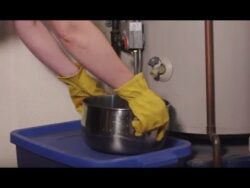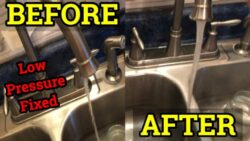In order to maintain a clean and hygienic bathroom, it is essential to address the issue of hard water stains in your toilet. These unsightly stains can build up over time, causing your toilet to appear dirty and uninviting. Fortunately, there are several effective methods for removing hard water stains that can restore the pristine condition of your toilet bowl. By implementing these proven techniques, you can eliminate stubborn hard water stains and ensure a sparkling clean toilet that enhances the overall cleanliness and aesthetics of your bathroom.
Preventive Measures
Regular Cleaning
Regular cleaning is one of the most effective preventive measures you can take to keep hard water stains from building up in your toilet bowl. By making cleaning a part of your regular household routine, you can minimize the formation of stubborn stains. Use a toilet brush and cleaner to scrub the bowl at least once a week, paying special attention to the areas beneath the rim where stains tend to accumulate.
Using a Toilet Bowl Cleaner
Using a toilet bowl cleaner specifically designed to remove hard water stains is an excellent preventive measure. These cleaners are formulated with ingredients that effectively break down mineral deposits and stains. Simply apply the cleaner around the inside of the bowl, allowing it to sit for a few minutes to penetrate the stains. Then, scrub with a toilet brush and flush to wash away the cleaner and stains.
Using a Toilet Tank Cleaner
Toilet tank cleaners are another preventive measure to consider. Hard water stains can also build up in the tank, which can affect the cleanliness of the water that is flushed into the bowl. Using a toilet tank cleaner regularly helps remove any mineral buildup and keeps the tank clean, contributing to a cleaner overall toilet bowl.
Installing a Water Softener
Installing a water softener is a more permanent preventive measure that can significantly reduce the occurrence of hard water stains in your toilet. Water softeners work by removing minerals like calcium and magnesium that cause hardness in the water. By using softened water in your toilet, you can prevent the formation of unsightly stains and minimize the amount of cleaning required. Consult a professional to assess your water quality and recommend the best water softener for your needs.
Natural Cleaning Solutions
Vinegar
Vinegar is a versatile and natural cleaning solution that can effectively remove hard water stains in your toilet bowl. Its acidic properties help dissolve mineral deposits and stains. To use vinegar, pour a generous amount into the bowl, making sure to cover the stains completely. Let it sit for a few hours or overnight, then scrub with a toilet brush and flush. Repeat if necessary until the stains are gone.
Baking Soda
Baking soda is another natural and commonly available cleaning agent that can be used to tackle hard water stains in the toilet. Its abrasive nature helps remove the stains without scratching the porcelain surface. To use baking soda, sprinkle it directly onto the stains and let it sit for a few minutes. Then, scrub the bowl with a toilet brush, focusing on the stained areas. Finally, flush the toilet to rinse away the baking soda and stains.
Lemon Juice
Lemon juice, with its high citric acid content, is a natural and effective solution for removing hard water stains. The acidic properties of lemon juice break down mineral deposits and stains on contact. Squeeze fresh lemon juice directly onto the stains and let it sit for about 15-30 minutes. Then, scrub the bowl with a toilet brush and flush. The pleasant citrus scent of lemon juice also helps in leaving your toilet smelling fresh and clean.
Borax
Borax is a multipurpose cleaner that can also be used to remove hard water stains in your toilet. Its alkaline properties make it effective at breaking down mineral deposits. To use borax, sprinkle it directly onto the stained areas of the toilet bowl. Let it sit for about 20 minutes, then scrub it with a toilet brush. Rinse thoroughly by flushing the toilet until the water runs clear.
Hydrogen Peroxide
Hydrogen peroxide is a powerful oxidizing agent that can effectively remove hard water stains from your toilet bowl. Its bubbling action helps dislodge mineral deposits and stains. Pour hydrogen peroxide directly onto the stains and let it sit for about 30 minutes. Then, scrub with a toilet brush and flush the toilet to remove the peroxide and stains. Remember to test a small inconspicuous area before using hydrogen peroxide to ensure it does not damage the toilet’s finish.
Commercial Cleaners
Acid-Based Cleaners
Acid-based cleaners are specifically formulated to remove tough stains and mineral deposits from toilet bowls. These cleaners contain ingredients like hydrochloric acid or phosphoric acid, which effectively dissolve hard water stains and limescale buildup. Follow the manufacturer’s instructions when using acid-based cleaners, as they can be corrosive and should be handled with care. Wear protective gloves and eye protection to ensure safety.
Bleach-Based Cleaners
Bleach-based cleaners, commonly known as chlorine bleach, are effective at removing stains and disinfecting the toilet bowl. The bleach helps break down mineral deposits and organic matter, leaving the bowl clean and free of stains. To use bleach-based cleaners, pour a small amount into the bowl, making sure to coat the stained areas. Let it sit for a few minutes, then scrub with a toilet brush and flush. Take caution when using bleach, as it can be harmful if ingested or mixed with certain other cleaning agents.
Calcium Lime Rust Removers
Calcium lime rust removers, also known as CLR cleaners, are specifically designed to tackle hard water stains and mineral deposits. These cleaners contain ingredients that dissolve calcium, lime, and rust buildup, leaving the toilet bowl clean and stain-free. Follow the instructions provided by the manufacturer when using CLR cleaners, as they may require a specific amount of time to penetrate and dissolve the stains. Always wear protective gloves and eye protection when using these strong chemical cleaners.
Enzymatic Cleaners
Enzymatic cleaners are a more environmentally friendly option for removing hard water stains in the toilet. These cleaners use specific enzymes to break down and dissolve organic matter and mineral deposits. Enzymatic cleaners are generally safe to use and do not contain harsh chemicals. Apply the cleaner to the stained areas and let it sit for the recommended time. Then, scrub with a toilet brush and flush. Enzymatic cleaners are often best suited for maintenance cleaning rather than heavily stained areas.
Mechanical Methods
Toilet Brush
A toilet brush is a fundamental tool for maintaining the cleanliness of your toilet bowl. Its bristles are designed to scrub away stains and buildup, making it an essential accessory for regular cleaning. Use a toilet brush in conjunction with any cleaning solution, whether natural or commercial, to effectively remove hard water stains. Ensure that you clean the brush after use to prevent the spread of germs and bacteria.
Pumice Stone
A pumice stone is a natural abrasive that can be used to remove stubborn hard water stains in the toilet bowl. Wet the pumice stone and gently scrub the stained areas, applying light pressure. The pumice stone will gradually wear down as you scrub, helping to remove the stains without scratching the porcelain. Rinse the toilet thoroughly after using a pumice stone to remove any residue.
Steel Wool
Steel wool is another option for mechanical stain removal in the toilet bowl. However, be cautious when using steel wool, as it can scratch the porcelain surface. Only use steel wool as a last resort for heavily stained areas and apply light pressure. Rinse the toilet thoroughly after using steel wool to remove any particles that may have been left behind.
Toilet Bowl Scrubber
A toilet bowl scrubber is a handheld tool that incorporates synthetic bristles and a scrub head to effectively remove stains from the toilet bowl. Choose a scrubber with medium to firm bristles to tackle hard water stains. Apply your preferred cleaning solution, whether natural or commercial, onto the bowl. Then, use the toilet bowl scrubber to scrub the stained areas, applying gentle pressure. Rinse the toilet thoroughly after scrubbing to remove any residue.
Chemical Techniques
Citric Acid
Citric acid is a naturally occurring acid found in citrus fruits and is widely used for cleaning purposes. Its acidic nature makes it effective at removing hard water stains. To use citric acid, apply a citric acid-based cleaner or sprinkle powdered citric acid directly onto the stained areas. Let it sit for about 30 minutes, then scrub with a toilet brush and flush. Citric acid is generally safe to use, but it is recommended to wear protective gloves and eye protection.
Oxalic Acid
Oxalic acid is a strong acid that can be used to remove tough hard water stains in the toilet bowl. It is commonly found in rust or stain removers and helps dissolve mineral deposits and rust. Follow the instructions provided with the product when using oxalic acid cleaners, as they may require specific dilution or handling instructions. Always wear protective gloves and eye protection when using oxalic acid, as it can be harmful if ingested or comes into contact with the skin.
Muriatic Acid
Muriatic acid, also known as hydrochloric acid, is a powerful acid that should be used with extreme caution. It is highly effective at removing hard water stains, but it can be corrosive and potentially hazardous if not handled properly. If you choose to use muriatic acid, follow the manufacturer’s instructions carefully and take all necessary safety precautions. Wear protective clothing, gloves, and eye protection, and ensure proper ventilation when using muriatic acid.
Boric Acid
Boric acid is a mild acid that can be used to remove hard water stains in the toilet. It is commonly found in natural cleaning products and is relatively safe to use. To use boric acid, sprinkle it directly onto the stained areas and let it sit for about 30 minutes. Scrub with a toilet brush and flush to wash away the stains. While generally safe, it is still recommended to wear protective gloves and eye protection when using boric acid.
Homemade Toilet Bowl Cleaner Recipes
Vinegar and Baking Soda
A simple homemade cleaner can be made by combining vinegar and baking soda. Start by pouring some vinegar into the toilet bowl, covering the stained areas. Let it sit for a few minutes, then sprinkle baking soda onto the stains. The mixture will create a bubbling reaction, which helps loosen and dissolve the stains. Scrub with a toilet brush and flush to remove the cleaner and stains.
Lemon Juice and Borax
Create a natural homemade cleaner by combining lemon juice and borax. Squeeze fresh lemon juice onto the stains and sprinkle borax over them. Let it sit for about 30 minutes, then scrub the bowl using a toilet brush. Finally, flush the toilet to rinse away the cleaner and stains. This homemade cleaner is an effective alternative to chemical-based options while leaving a refreshing lemon scent.
Hydrogen Peroxide and Citric Acid
Another homemade formula for removing hard water stains can be made using hydrogen peroxide and citric acid. Mix equal parts hydrogen peroxide and powdered citric acid to form a paste. Apply the paste to the stained areas and let it sit for about 30 minutes. Scrub the bowl with a toilet brush and flush to rinse away the paste and stains. Take caution when using hydrogen peroxide and citric acid, as they can have bleaching effects on clothing and surfaces.
Effective Cleaning Tools
Toilet Bowl Brush
A toilet bowl brush is an essential tool for effectively cleaning the toilet bowl. Choose a brush with sturdy bristles that can reach all areas of the bowl, including under the rim. Regularly clean the brush after each use to prevent the spread of germs and bacteria. Replace the brush as needed to ensure optimal cleaning performance.
Sponge or Cloth
Sponges or cloths are useful for wiping down the exterior surfaces of the toilet, such as the tank, lid, and base. Choose a sponge or cloth that is suitable for cleaning and use it in conjunction with your preferred cleaning solution. Wipe down the surfaces thoroughly and rinse the sponge or cloth after use to maintain hygiene.
Spray Bottle
A spray bottle is a convenient tool for applying cleaning solutions to the toilet bowl. Fill the spray bottle with your preferred cleaning solution, whether it is a homemade recipe or a commercial cleaner. Spray the solution onto the stained areas, ensuring good coverage. The spray bottle allows for targeted application and helps minimize wasted products.
Scrub Brush
A scrub brush can be used in addition to a toilet brush for more intensive cleaning of stubborn hard water stains. Choose a scrub brush with stiff bristles that can effectively scrub away stains without damaging the toilet’s surface. Use the scrub brush in conjunction with your chosen cleaning solution, applying friction to loosen and remove the stains. Rinse the brush thoroughly after each use.
Scrubbing Techniques
Circular Motion
When scrubbing the toilet bowl, use a circular motion to cover all areas and ensure thorough cleaning. Start at the top of the waterline and work your way down to the bottom, focusing on the stained areas. Applying moderate pressure, move the toilet brush or scrub brush in circular motions to dislodge and remove the stains. Rinse the brush frequently and continue until the stains are no longer visible.
Back and Forth Motion
In addition to circular motions, a back-and-forth motion can help tackle difficult hard water stains. After applying your preferred cleaning solution, scrub the stained areas using a back-and-forth motion with the toilet brush or scrub brush. This motion helps to loosen and break up the stains effectively. Continue scrubbing until the stains are removed, rinsing the brush frequently to prevent spreading the stains.
Under-rim Cleaning
The area under the rim of the toilet bowl is often neglected and can be a hotspot for hard water stains. To clean this area effectively, apply your chosen cleaning solution and use the toilet brush or a scrub brush to scrub underneath the rim. Make sure to reach all areas, as stains can easily accumulate in hard-to-reach spots. Rinse the brush frequently and pay attention to the water level during cleaning to avoid splashing.
Hard-to-Reach Areas
Some hard water stains may be located in hard-to-reach areas, such as the hinges of the toilet seat or in narrow crevices. Use a toothbrush or small scrub brush to reach these areas and apply your chosen cleaning solution. Scrub gently to avoid damaging the surface or causing scratches. Rinse the brush frequently and continue until the stains are removed. Take extra care when cleaning delicate parts of the toilet to prevent any unwanted damage.
Safety Precautions
Protective Gloves
When cleaning a toilet, it is important to protect your hands by wearing appropriate gloves. Cleaning agents, especially those containing acids or chemicals, may cause skin irritation or allergic reactions. Choose gloves made of durable materials, such as rubber or latex, that provide sufficient protection. Ensure the gloves fit properly and are in good condition before starting the cleaning process.
Eye Protection
To protect your eyes from potential splashes or exposure to cleaning agents, it is advisable to wear protective eyewear. Accidental splashes or aerosolized particles can easily come into contact with your eyes while cleaning the toilet. Safety goggles or glasses with side shields provide effective protection against chemical splashes and debris. Prioritize safety by wearing eye protection when cleaning your toilet.
Ventilation
Proper ventilation is essential when using cleaning agents, especially those with strong odors or potentially harmful fumes. Open windows or doors to create airflow and remove any lingering odors or fumes from the cleaning process. This helps to ensure a fresh and safe environment while minimizing exposure to potentially harmful chemicals. Remember to also follow the recommended guidelines provided by the manufacturer of the cleaning products.
Avoid Mixing Chemicals
One crucial safety precaution to always remember is to never mix different cleaning chemicals together. Mixing chemicals can result in potentially dangerous and toxic reactions. Some combinations can produce toxic gases or explosions, posing serious health risks. Always read and follow the instructions on cleaning product labels, and avoid using multiple cleaning agents simultaneously. When in doubt, choose one specific cleaning agent suitable for your needs to ensure safety.
Professional Cleaning Services
Benefits of Hiring Professionals
Hiring professional cleaning services for your toilet can provide a range of benefits. Professionals have the expertise and experience to effectively remove hard water stains and ensure a thorough cleaning. They use specialized equipment and cleaning agents that may not be available to the general public. Professional cleaners are also trained to handle potentially hazardous materials, ensuring safety during the cleaning process. By hiring professionals, you can save time and effort while achieving optimal results.
Cost Considerations
The cost of hiring professional cleaning services for your toilet can vary depending on several factors. These factors include the size of the toilet, the extent of the stains, and the frequency of the cleaning service. It is advisable to research local cleaning companies and request quotes to compare prices. Consider the value of professional expertise and equipment when assessing the cost. Remember that investing in professional services can save you time and potentially prevent damage to your toilet in the long run.
Frequency of Service
The frequency of professional cleaning services for your toilet depends on several factors, including personal preference, household usage, and the severity of hard water stains. It is recommended to have professionals clean your toilet at least once every few months to maintain cleanliness and prevent the buildup of stubborn stains. However, you may choose to schedule more frequent cleanings if hard water is a persistent issue in your area. Consult with professional cleaning companies to determine the best frequency for your specific needs.
Choosing a Reputable Cleaning Company
When selecting a professional cleaning company for your toilet, it is important to choose a reputable and reliable provider. Consider factors such as company reputation, customer reviews, and years of experience in the industry. Additionally, ensure that the company is licensed, bonded, and insured to guarantee that you are protected in case of any accidents or damages during the cleaning process. Request references and ask for a detailed explanation of the services provided to ensure that they meet your expectations.





